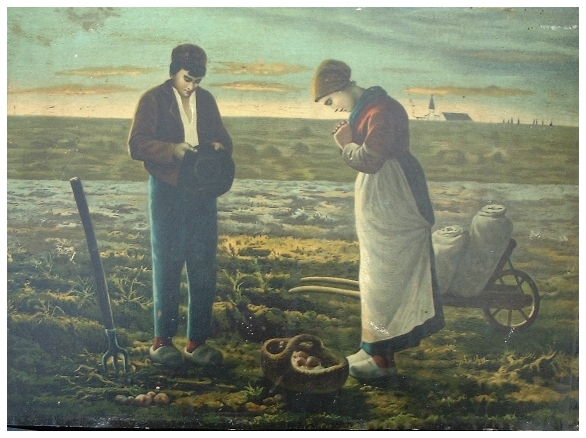The Angelus (1859) Jean Francois Millet 1819-1875

The Angelus
The Angelus is traditionally recited morning (6:00 a.m.), noon and evening (6:00 p.m.) throughout the year except during Paschal time, when the Regina Coeli is recited instead.
|
V. The Angel of the Lord declared unto Mary.
V. Behold the handmaid of the Lord.
V. And the Word was made Flesh. V. Pray for us, O holy Mother of God. |
LET US PRAY
Pour forth, we beseech Thee, O Lord, Thy grace into our hearts, that we to whom the Incarnation of Christ Thy Son was made known by the message of an angel, may by His Passion and Cross be brought to the glory of His Resurrection. Through the same Christ Our Lord. Amen.
History of the painting by Millet
Millet's Angelus must be one of the most famous 19th century French
paintings. It was originally painted for a private collector but after quite a
number of different homes, it was bought for the French people and now hangs in
the
Musee D'Orsay in Paris.
Millet was born into a pious and hard-working country family in Gruchy near
Cherbourg in Northern France. Both his parents instilled in him a love of the
faith and its devotions, including the daily recitation of the Angelus.
In later years, Jean Francois would recall his father after he had returned home
from work, taking off his beret and standing up in the kitchen when the bell for
the evening angelus sounded. He also recalled
the peasant workers in the fields who stopped to pray at midday and evening, a
theme he incorporated into this picture of two farm people praying the evening
Angelus.
The evening light gives the setting a warm and intimate feeling, we see tools
and produce next to the two people as they stand with their heads bent in
prayer. In the distance, we can just find the top of the church spire and as
Millet said himself, "we can almost hear the angelus bell."
In recent years, many of the older customs and devotions of the Church have
disappeared, perhaps some no longer appeal to newer generations, but strangely
the Angelus has enjoyed a resurgence.
In France, for instance, you can still find it rung in most villages and towns
at the traditional times of day, morning, midday and evening. In Ireland and
over in Britain, churches that have bells have returned to the ancient practice
of sounding the Angelus, three strokes of the bell, chimed three times followed
by nine strokes or, as is the custom abroad, a longer and more freely swung
ring.
The Angelus has a long history. Begun in the 13th century, it commemorates the
Incarnation, and consists of three verses and responses, each one followed by
the Hail Mary and ending with a prayer. Traditionally, the three times of the
day are associated with particular stages of Christ's life: the morning, the
Resurrection, the midday, the Passion and the evening the Incarnation.
If we look at Millet's picture, it may inspire us to follow the exhortation of
Paul VI in Marialis Cultus ( 1974) and make the Angelus our daily prayer.
Article by Dr Robin Gibbons, senior lecturer at St Mary's College, Twickenham












